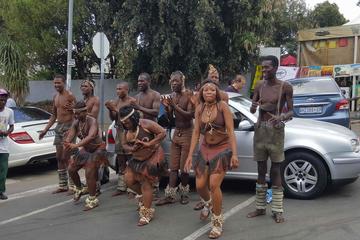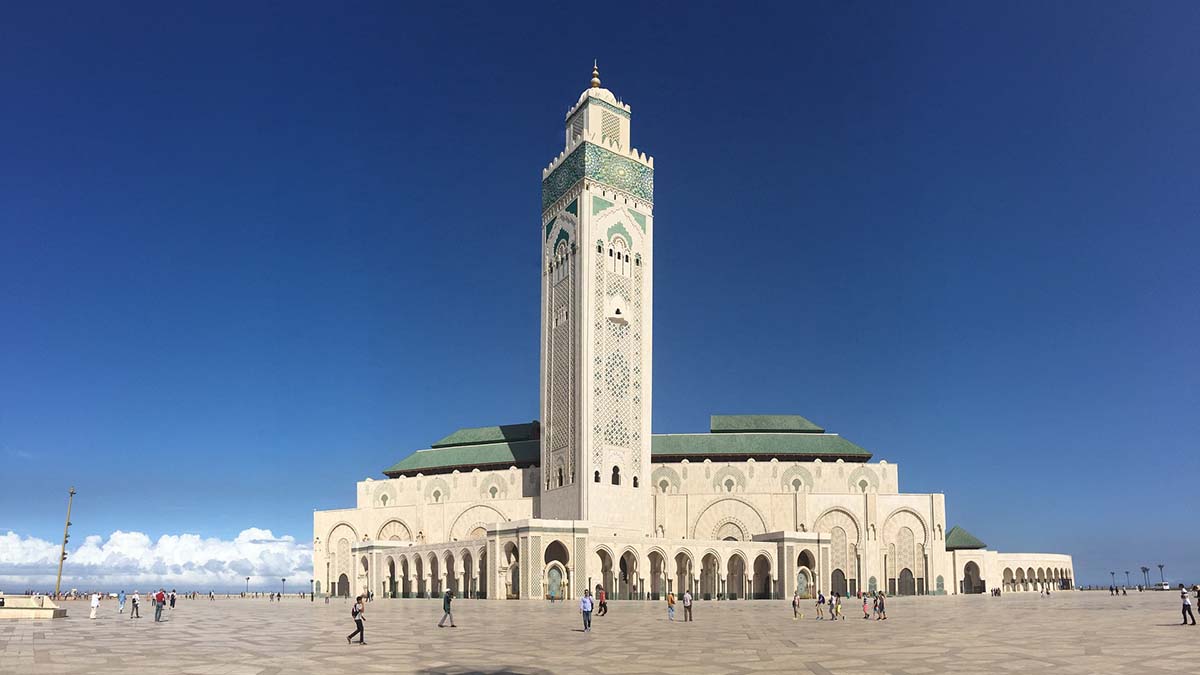
by Elizabeth von Pier
Marrakech was our first stop in Morocco. Founded in 1062 and known as the “ochre city” for the color of the buildings and walls in the old Arab section, we entered the city on wide boulevards teeming with traffic, chain hotels, modern white stucco buildings and palm trees. I felt disappointed; we could have been somewhere in Florida. But then we passed through the old city walls and a park where camels were sitting in a shady grove. People strolled the streets wearing their traditional jellabiyas and “calls to prayer” were coming from loudspeakers on the minarets of the mosques. This was Morocco!
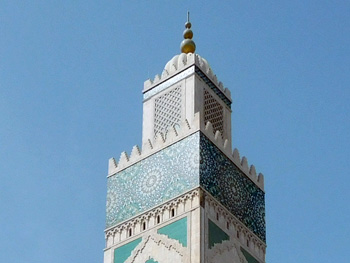 We were staying in a riad, and this one turned out to be a destination in itself. A “riad” is a traditional Moroccan house, located within the ancient medina and designed around a central courtyard, pool or fountain, and garden. The owners had purchased several adjoining houses and combined them so that there are two courtyards and 26 guest rooms, several sitting rooms, two restaurants, a jazz bar, and a spa. The hotelier gave us a tour and showed us to a lovely room which faced the pool and inner courtyard. As I stood on the balcony, I looked out over rooftops of the old city and a minaret a short distance away. Down below was a pool, trees, potted plants, tables covered with white tablecloths, pierced pendant lanterns, and lovely tile work. Each morning at dawn, we were awakened to the “call to prayer” from the mosque. A traditional afternoon tea is offered in the courtyard each day, and we enjoyed typically Moroccan mint tea served with an assortment of tiny cookies. It felt like something out of “Arabian Nights”.
We were staying in a riad, and this one turned out to be a destination in itself. A “riad” is a traditional Moroccan house, located within the ancient medina and designed around a central courtyard, pool or fountain, and garden. The owners had purchased several adjoining houses and combined them so that there are two courtyards and 26 guest rooms, several sitting rooms, two restaurants, a jazz bar, and a spa. The hotelier gave us a tour and showed us to a lovely room which faced the pool and inner courtyard. As I stood on the balcony, I looked out over rooftops of the old city and a minaret a short distance away. Down below was a pool, trees, potted plants, tables covered with white tablecloths, pierced pendant lanterns, and lovely tile work. Each morning at dawn, we were awakened to the “call to prayer” from the mosque. A traditional afternoon tea is offered in the courtyard each day, and we enjoyed typically Moroccan mint tea served with an assortment of tiny cookies. It felt like something out of “Arabian Nights”.
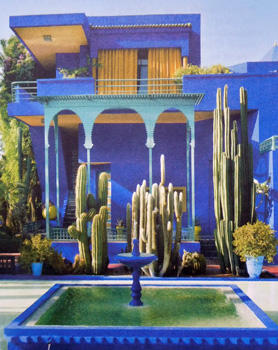 Within walking distance of the riad is the Majorelle Garden, a botanical and landscape garden that was created in the 1920’s by French painter Jacques Majorelle. It is a fantastical delight and beautiful to behold. Special shades of bold cobalt blue are used in the gardens and on the buildings, walkways and pergolas, and are a stunning accent to the greens of the cacti, palm trees, bamboo, bougainvilleas, and ferns. Neglected after the painter’s death in 1962, the property was later restored by fashion designer Yves Saint-Laurent who bought the garden and used it as his residence. After he died in 2008, his ashes were scattered in the garden and a memorial was built in his honor.
Within walking distance of the riad is the Majorelle Garden, a botanical and landscape garden that was created in the 1920’s by French painter Jacques Majorelle. It is a fantastical delight and beautiful to behold. Special shades of bold cobalt blue are used in the gardens and on the buildings, walkways and pergolas, and are a stunning accent to the greens of the cacti, palm trees, bamboo, bougainvilleas, and ferns. Neglected after the painter’s death in 1962, the property was later restored by fashion designer Yves Saint-Laurent who bought the garden and used it as his residence. After he died in 2008, his ashes were scattered in the garden and a memorial was built in his honor.

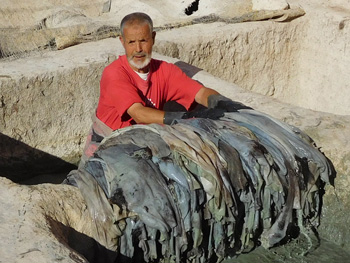 The “souk” is the commercial quarter of the medina and we went there to experience the activity and to bargain for some souvenirs. Colorful stalls line the alleyways, selling everything from carpets to clothing, scarves, jewelry, leather products, olives and housewares. We were on a quest to find a decorative tagine like the ones used on our riad’s breakfast buffet for fruits, nuts and pastries. Mohammed patiently took us from stall to stall until my sister finally found one to bring back home with her. There are no set prices in the souk so she had to use her bargaining skills. It can get rather tense as the seller dramatically tells the buyer that she is “killing” him with the low price she is offering. But in the end, she prevailed and took home a beautiful tagine to use for entertaining in the Moroccan style.
The “souk” is the commercial quarter of the medina and we went there to experience the activity and to bargain for some souvenirs. Colorful stalls line the alleyways, selling everything from carpets to clothing, scarves, jewelry, leather products, olives and housewares. We were on a quest to find a decorative tagine like the ones used on our riad’s breakfast buffet for fruits, nuts and pastries. Mohammed patiently took us from stall to stall until my sister finally found one to bring back home with her. There are no set prices in the souk so she had to use her bargaining skills. It can get rather tense as the seller dramatically tells the buyer that she is “killing” him with the low price she is offering. But in the end, she prevailed and took home a beautiful tagine to use for entertaining in the Moroccan style.
We expected to engage in this type of buying and selling process in the souk. But we did not expect the tactics used on the street to capture the attention of the unsuspecting tourist. Men posing as workers in our riad who had the day off said they recognized us from the riad and shared important information about a special shop a couple of streets away. A co-conspirator “happened” to overhear the conversation and offered to show us the way. We started to follow, but then thought better of it. A sign on the wall in the riad warned about these tactics, but we had not noticed it. And to think we almost fell for it! We probably won’t see these “actors” on the big screen anytime soon, but their performance and timing was so well executed that I feel they deserve every dirham of their commissions.
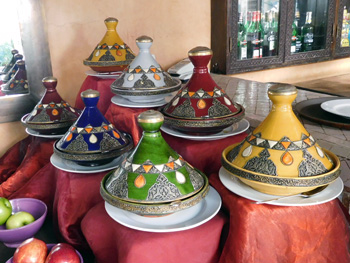 There also was an interesting specialty shop in the souk where three Berber women were laboriously extracting oil from the nuts of the argan tree to make food products and cosmetics. Argan trees are endemic to Morocco and the oil that is extracted is very precious and has many health benefits. A salesman let us sample some of their special products, and we filled our baskets with gifts for people back home. There was no bargaining here because supposedly this is the only place where the skin products are pure and the oils used for cooking are not diluted.
There also was an interesting specialty shop in the souk where three Berber women were laboriously extracting oil from the nuts of the argan tree to make food products and cosmetics. Argan trees are endemic to Morocco and the oil that is extracted is very precious and has many health benefits. A salesman let us sample some of their special products, and we filled our baskets with gifts for people back home. There was no bargaining here because supposedly this is the only place where the skin products are pure and the oils used for cooking are not diluted.
Leaving the souk, we entered the beating heart of the city, Place Jemaa El Fna, which dates from the 12th century and was designated a UNESCO world heritage site in 2001. This is a large square inside the walled city, lined with restaurants and shops and the setting for performances by snake charmers, musicians, storytellers, fortune-tellers, henna artists, monkey performers, acrobats, and transvestite dancers. It indeed is an assortment of fantastic sights and smells of Moroccan folklore. One photo here will cost you ten dirham.
 The Koutoubia Mosque with its 254 foot high minaret is a landmark and symbol of the city. We were just outside the mosque when the “call to prayer” came from the loudspeakers above. Not far away is the Bahia Palace, a masterpiece of Moroccan architecture with its brilliant mosaics, carved woodwork and gorgeous marbles. Like most Arab palaces, it contains charming and tranquil gardens, beautiful patios and rooms richly decorated with tiles. And we visited the tombs of the Saâdi rulers which date back to the 16th century but were only discovered and restored around 1917. These tombs shelter the bodies of about 60 Saadian sultans and their families and are an outstanding example of Moorish tilework and art.
The Koutoubia Mosque with its 254 foot high minaret is a landmark and symbol of the city. We were just outside the mosque when the “call to prayer” came from the loudspeakers above. Not far away is the Bahia Palace, a masterpiece of Moroccan architecture with its brilliant mosaics, carved woodwork and gorgeous marbles. Like most Arab palaces, it contains charming and tranquil gardens, beautiful patios and rooms richly decorated with tiles. And we visited the tombs of the Saâdi rulers which date back to the 16th century but were only discovered and restored around 1917. These tombs shelter the bodies of about 60 Saadian sultans and their families and are an outstanding example of Moorish tilework and art.
Leaving Marrakech two days later, we transferred to a four-wheel drive vehicle for our trip over the High Atlas Mountains via the Tizin Tichka Pass. Our destination was Ouarzazate, five hours away. Mohammed expertly navigated the vehicle around hairpin turns and over narrow roads that came within inches of steep drop-offs into canyons below. Besides the scenery, the sights we saw along the way are memorable. Donkeys loaded with meat, produce and wheat were led by jellabiya-clad men to village markets high in these mountains. We passed caves used by the Bedouins, nomadic tribes who live mainly in the desert but use the caves when crossing the mountains on their camels. We caught a glimpse of a road worker pausing for prayer on an outcrop of the mountain. And we saw stork nests, shepherds tending their flocks, and tiny villages made out of sandstone and hay that blend into the color of the hillsides on which they are built. No matter how small the village, there’s always a mosque with its minaret towering above everything.
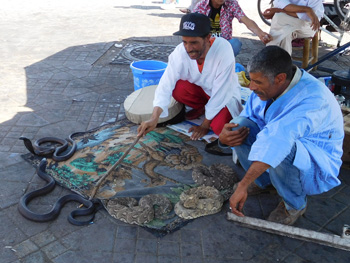 Ouarzazate, nicknamed “the door of the (Sahara) Desert”, was built as a garrison and administrative center by the French, but today it serves as the Hollywood of the Kingdom. This is where “Lawrence of Arabia”, “Jesus of Nazareth”, “Gladiator”, “Indiana Jones” and many other films were made. While it is in a lovely setting, the town itself is somewhat tacky. There are several movie studios that you can tour and new housing developments are springing up in the otherwise beautiful landscape.
Ouarzazate, nicknamed “the door of the (Sahara) Desert”, was built as a garrison and administrative center by the French, but today it serves as the Hollywood of the Kingdom. This is where “Lawrence of Arabia”, “Jesus of Nazareth”, “Gladiator”, “Indiana Jones” and many other films were made. While it is in a lovely setting, the town itself is somewhat tacky. There are several movie studios that you can tour and new housing developments are springing up in the otherwise beautiful landscape.
There are some interesting and beautiful casbahs nearby that have also been the setting for movies. Mohammed led us through the old rooms of the Kasbah de Taourirt and the alleyways of the more famous Ait Benhaddou, both sandstone in color and very picturesque. They show how tribes lived and protected themselves in former times. The pathways into Ait Benhaddou are filled with shops and artisans working at their crafts. A woman sitting on her stoop invited us to see her home. She showed us her “old” kitchen with its bee-hive oven, her “modern” kitchen with its fifties-style sink and tile backsplash, and a small room open to the sky where the sheep were housed in very tight quarters. The living room was full of carpets that she supposedly made herself and would sell for a good price. So the tip we gave her was really for the privilege of visiting her shop. Fooled again!
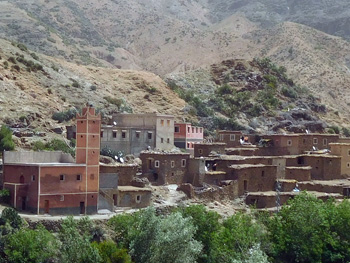 Leaving casbah Ait Benhaddou, we drove for miles through the foothills of the mountains and the rolling sand hills of the desert and started to wonder where we could possibly be staying for the night. Hopefully not in a Bedouin tent! But when we finally came upon our riad, we drove through a large sandstone arch and entered a typical Moroccan courtyard, set in an oasis with palm trees and beautiful plantings around a central pool and fountain. You’d never expect to find a place like this here in such a remote location. But it does make sense—a Frenchman opened it to cater to the movie industry.
Leaving casbah Ait Benhaddou, we drove for miles through the foothills of the mountains and the rolling sand hills of the desert and started to wonder where we could possibly be staying for the night. Hopefully not in a Bedouin tent! But when we finally came upon our riad, we drove through a large sandstone arch and entered a typical Moroccan courtyard, set in an oasis with palm trees and beautiful plantings around a central pool and fountain. You’d never expect to find a place like this here in such a remote location. But it does make sense—a Frenchman opened it to cater to the movie industry.
In order to get to Casablanca, our next and final destination, we had to drive back over the High Atlas Mountains. Casablanca is very busy and teeming with traffic but it has a beautiful new mosque. Hassan II is one of the world’s largest and it was built over six years from “contributions” made by every family in in the city. We also drove by and took photos of Rick’s Café made famous by the film “Casablanca”, and toured the medina with its maze-like streets that are almost impossible to navigate in a car. Everywhere in Casablanca, the driving was terrifying, partly because people play “chicken” as they maneuver in and out of traffic. Unfortunately for us, Mohammed was very good at playing “chicken”.
The Islamic month of Ramadan had just started and Mohammed had fasted all that day as we made the long journey from Ouarzazate. Ramadan is a time of spiritual reflection and increased devotion and worship which is observed as a month of fasting from sunrise to sunset. So early that evening, we arrived at the hotel very hungry after the long drive and had to wait until the sun set for food to be served. We were the first ones in the restaurant when the sun hit the horizon!
If You Go:
♦ Riad in Marrakech, La Maison Arabe in the Medina
♦ Riad in Ouarzazate, Riad Ksar Ighnda
♦ Hotel in Casablanca, Sofitel Tour Blanche
About the author:
Elizabeth von Pier is a retired banker and photojournalist who travels extensively throughout the world. In her retirement, she has written and published articles in travelmag.co.uk, WAVE Journey, Travel Thru History and hackwriters.com. Ms. von Pier lives in Hingham, Massachusetts.
First photo by danyloz2002 from Pixabay
All other photos are by Elizbeth von Pier:
Minaret
Majorelle Garden
Tannery worker
Tagines
Women extracting argan oil
Snake charmers in Place Jemaa El Fna
Village in High Atlas Mountains
Movie studio

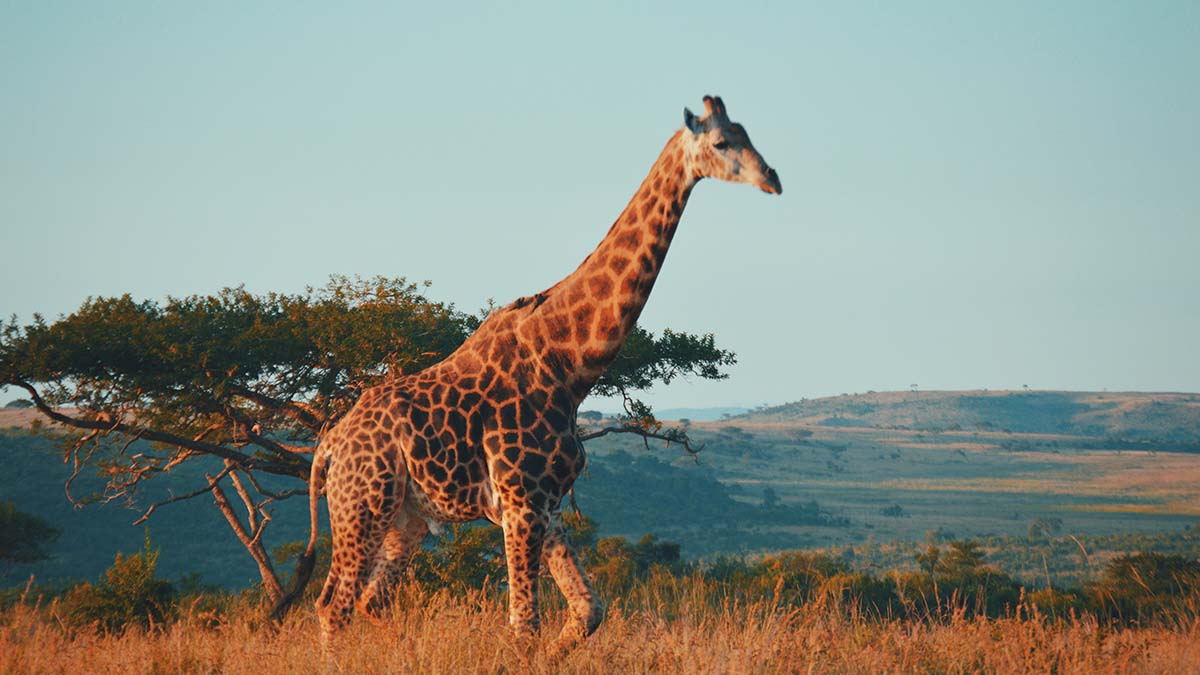
 As you fly into Johannesburg you would expect to see the wild game from the runway. Close to the tarmac is a beautiful view of elephant grass (tall grasses) and native trees that bring memories of photos depicting Africa or the Lion King. I travelled there in August which would be the southern hemisphere winter. Well, if that is winter, it sure does not resemble the Canadian winters. Each day, whether in Johannesburg, Pretoria, Durban, or Capetown all provided an average temperature between 26 to 29C each day and sunshine over my three week adventure. South Africa winter certainly is quite manageable.
As you fly into Johannesburg you would expect to see the wild game from the runway. Close to the tarmac is a beautiful view of elephant grass (tall grasses) and native trees that bring memories of photos depicting Africa or the Lion King. I travelled there in August which would be the southern hemisphere winter. Well, if that is winter, it sure does not resemble the Canadian winters. Each day, whether in Johannesburg, Pretoria, Durban, or Capetown all provided an average temperature between 26 to 29C each day and sunshine over my three week adventure. South Africa winter certainly is quite manageable.
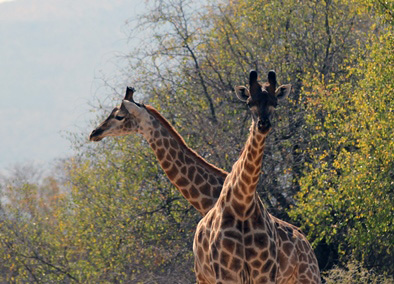 My first experience in SA was a 1.5 hr drive to Sun City. If you have watched the movie Blended you will have seen one of the hotels as the movie was filmed at Sun City Palace and the complex. There are four hotels on the premises ranging up to $8000 per night. Something for everyone, Players golf course, a children’s arcade, spa, casino, and high tea at 3 pm is highly recommended to see the Sun Palace hotel as that is the only access to this posh hotel.
My first experience in SA was a 1.5 hr drive to Sun City. If you have watched the movie Blended you will have seen one of the hotels as the movie was filmed at Sun City Palace and the complex. There are four hotels on the premises ranging up to $8000 per night. Something for everyone, Players golf course, a children’s arcade, spa, casino, and high tea at 3 pm is highly recommended to see the Sun Palace hotel as that is the only access to this posh hotel.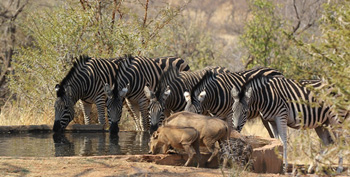 Food is also a bargain either at the grocery store or at the restaurants. Kentucky Fried Chicken appeared to be the most popular fast food to be found in SA with Macdonald’s a close second. KFC signage is atop the illuminated street names and almost on every street corner similar to Starbucks can be found in Canada. Both KFC and MacDonald’s offer free scooter delivery service for orders. Other restaurants offer bountiful breakfasts that can be found for around $3. Restaurants are also inexpensive offering lunch specials ranging from R57 ($5.70 CDN) which includes a salad and portions that are monstrous. Bottles of wine can start at R110 and up in a restaurant and beer at R25. Evening dinner options can be a full chicken and salad for R90. That would be a feast for a big appetite or a feast and a take home feast for the lighter appetites. Don’t worry if you don’t finish that bottle of wine. You can take it home. Most places appear to be children friendly with play areas and some even have child attendants. Some restaurants offer a complete experience for children to order their own pizza and help the chef make their pizza. Children put on their own toppings while the parents can enjoy a leisurely lunch or dinner.
Food is also a bargain either at the grocery store or at the restaurants. Kentucky Fried Chicken appeared to be the most popular fast food to be found in SA with Macdonald’s a close second. KFC signage is atop the illuminated street names and almost on every street corner similar to Starbucks can be found in Canada. Both KFC and MacDonald’s offer free scooter delivery service for orders. Other restaurants offer bountiful breakfasts that can be found for around $3. Restaurants are also inexpensive offering lunch specials ranging from R57 ($5.70 CDN) which includes a salad and portions that are monstrous. Bottles of wine can start at R110 and up in a restaurant and beer at R25. Evening dinner options can be a full chicken and salad for R90. That would be a feast for a big appetite or a feast and a take home feast for the lighter appetites. Don’t worry if you don’t finish that bottle of wine. You can take it home. Most places appear to be children friendly with play areas and some even have child attendants. Some restaurants offer a complete experience for children to order their own pizza and help the chef make their pizza. Children put on their own toppings while the parents can enjoy a leisurely lunch or dinner. Driving is an experience. Although sidewalks are a rare finding, the large dirt sections next to the road offer opportunities for vendors to set up business and cars can pull off the road to shop; SA people are very enterprising. On most traffic lighted city street corners, men can be found wandering between the lanes selling most anything: Newspapers, toys, pens, crafts, computer gadgets, but I did not see a kitchen sink. Companies and businesses also hire people to advertise at the street light corners to hand out pamphlets. It is always recommended, no matter where you may be in the world, to travel and drive with your doors locked. As anywhere, there are places that you should not venture for safety reasons. Having said that, I did not experience any adverse experiences. In SA taxi services are communal for the locals. Specific hand gestures indicate where you want to travel as the taxi vans travel the streets. People are packed 4 across and 5 deep holding over 20 people per taxi van.
Driving is an experience. Although sidewalks are a rare finding, the large dirt sections next to the road offer opportunities for vendors to set up business and cars can pull off the road to shop; SA people are very enterprising. On most traffic lighted city street corners, men can be found wandering between the lanes selling most anything: Newspapers, toys, pens, crafts, computer gadgets, but I did not see a kitchen sink. Companies and businesses also hire people to advertise at the street light corners to hand out pamphlets. It is always recommended, no matter where you may be in the world, to travel and drive with your doors locked. As anywhere, there are places that you should not venture for safety reasons. Having said that, I did not experience any adverse experiences. In SA taxi services are communal for the locals. Specific hand gestures indicate where you want to travel as the taxi vans travel the streets. People are packed 4 across and 5 deep holding over 20 people per taxi van.
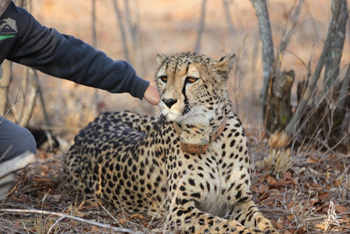 Mabalingwe was my first experience in a wild game reserve. This is under two hours from Pretoria. Your first view of a kudu, impala or warthog is exhilarating and you can’t get your camera poised fast enough. After a while the appetite for photographing new wild game gets more and more intriguing. The first 24 hours I had sited and photographed 14 different wild African animals in their natural environment. This included the ostrich, impala, kudu, baboon, warthog, bandit mongoose, giraffe, zebra, hippopotamus, crocodile, hyrax, duiker, hyala, and jackal. Patience is a virtue and wild animals do not pose or come out from behind the brushes. They do, however, need water and that is a good place to see many different animals. The best time of the day to find animals is the early morning and closer to the end of the day. Even in winter, midday is too warm for the animals and they siesta until closer to the end of day. Our morning safari were as early as 6 am and the sunset safari started at 3 pm as it becomes dark around 6 pm.
Mabalingwe was my first experience in a wild game reserve. This is under two hours from Pretoria. Your first view of a kudu, impala or warthog is exhilarating and you can’t get your camera poised fast enough. After a while the appetite for photographing new wild game gets more and more intriguing. The first 24 hours I had sited and photographed 14 different wild African animals in their natural environment. This included the ostrich, impala, kudu, baboon, warthog, bandit mongoose, giraffe, zebra, hippopotamus, crocodile, hyrax, duiker, hyala, and jackal. Patience is a virtue and wild animals do not pose or come out from behind the brushes. They do, however, need water and that is a good place to see many different animals. The best time of the day to find animals is the early morning and closer to the end of the day. Even in winter, midday is too warm for the animals and they siesta until closer to the end of day. Our morning safari were as early as 6 am and the sunset safari started at 3 pm as it becomes dark around 6 pm.

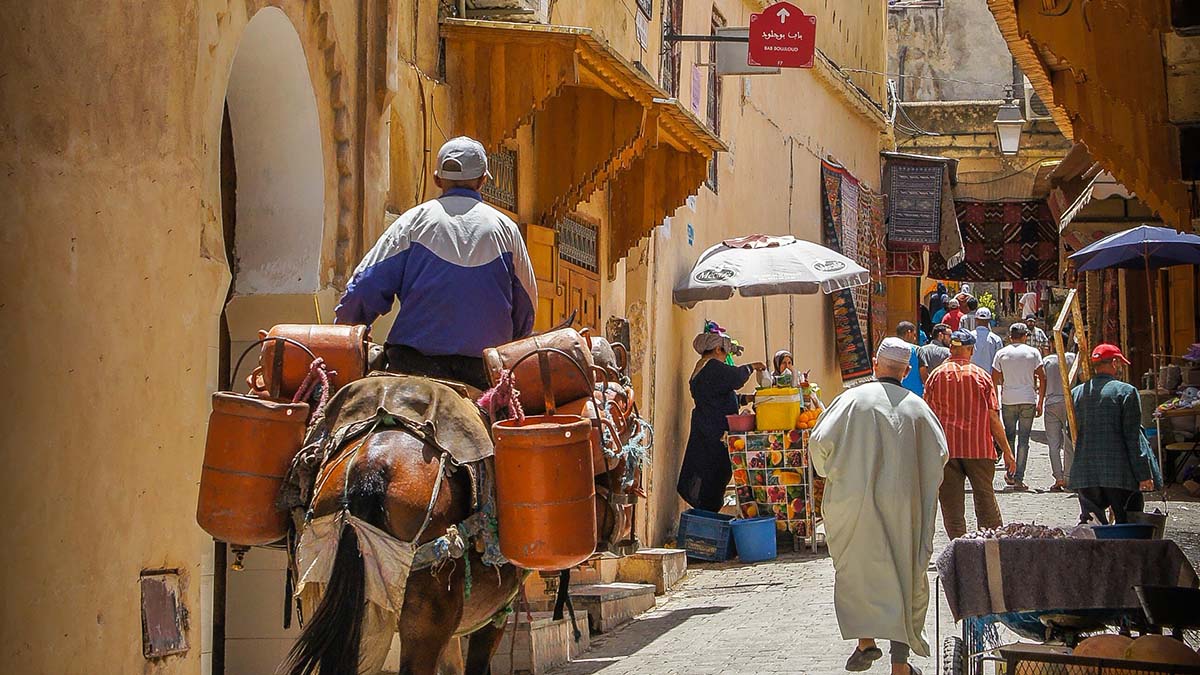
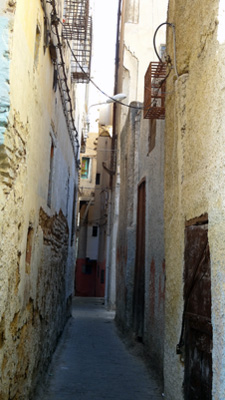 “Balak!”
“Balak!”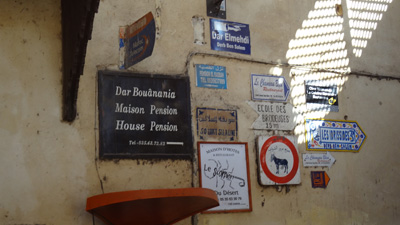 We amble down Talaa Kebira, one of the medina’s principal roadways, and soon come to Bou Inania Medersa. This is the most awe-inspiring Koranic school in Fes, and one of the few open to the public. Every room has lofty, sumptuously detailed ceilings with carved cedar beams and stunning onyx marble floors. The walls are covered with handcrafted tiles adorned with dazzling gold and turquoise geometric motifs. Intricate lime-coloured geometrical designs are also on display in the courtyard, where the 14th Century fountain still gushes today. In a corner an imam, a priest, kneels and chants verses from the Koran.
We amble down Talaa Kebira, one of the medina’s principal roadways, and soon come to Bou Inania Medersa. This is the most awe-inspiring Koranic school in Fes, and one of the few open to the public. Every room has lofty, sumptuously detailed ceilings with carved cedar beams and stunning onyx marble floors. The walls are covered with handcrafted tiles adorned with dazzling gold and turquoise geometric motifs. Intricate lime-coloured geometrical designs are also on display in the courtyard, where the 14th Century fountain still gushes today. In a corner an imam, a priest, kneels and chants verses from the Koran.
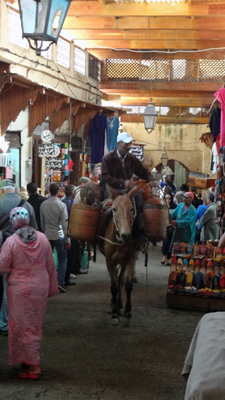 As we descend further into the bowels of the medina, our guide urges us to stay close together. She doesn’t have to tell me twice. I would love nothing better than to wander the zigzag of avenues on my own, but finding my way out would be nothing short of a miracle. I’m told that even the best maps are unreliable. The streets are swarming with humanity today; the thrum of voices is omnipresent. Since none of the roads are wide enough for cars to navigate, donkey carts and scooters are the accepted modes of transport, making this the world’s largest urban car-free zone.
As we descend further into the bowels of the medina, our guide urges us to stay close together. She doesn’t have to tell me twice. I would love nothing better than to wander the zigzag of avenues on my own, but finding my way out would be nothing short of a miracle. I’m told that even the best maps are unreliable. The streets are swarming with humanity today; the thrum of voices is omnipresent. Since none of the roads are wide enough for cars to navigate, donkey carts and scooters are the accepted modes of transport, making this the world’s largest urban car-free zone.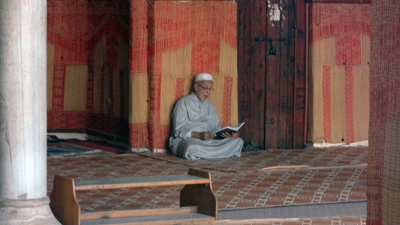 From the Souk Attarine our odyssey continues. Blind alleys that seem to lead nowhere open onto swarming fundouks with gurgling fountains. We pass countless vendors that hawk candles, wood carvings, jewelry, and fresh herbs from shops hardly bigger than a closet. A posse of young boys plays a boisterous game of soccer with two rocks serving as goalposts. The frenetic energy of it all is exhilarating.
From the Souk Attarine our odyssey continues. Blind alleys that seem to lead nowhere open onto swarming fundouks with gurgling fountains. We pass countless vendors that hawk candles, wood carvings, jewelry, and fresh herbs from shops hardly bigger than a closet. A posse of young boys plays a boisterous game of soccer with two rocks serving as goalposts. The frenetic energy of it all is exhilarating.
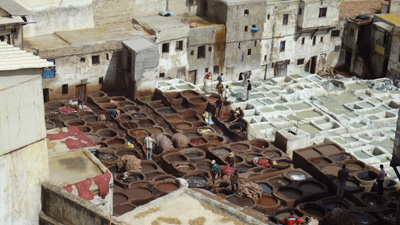 There is one last stop on our schedule, and we don’t need a map to find it. The rank stench of the open air leather tanneries serves as a guidepost to one of Fes’ most famous attractions. We’re led up a staircase to a leather shop that opens onto a terrace where we view the tanneries below.
There is one last stop on our schedule, and we don’t need a map to find it. The rank stench of the open air leather tanneries serves as a guidepost to one of Fes’ most famous attractions. We’re led up a staircase to a leather shop that opens onto a terrace where we view the tanneries below.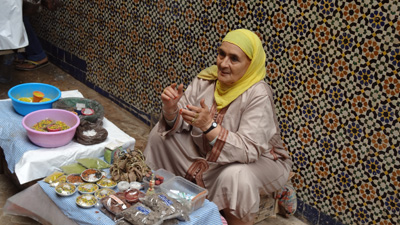 We’re seated on plush cushions around hand-carved wooden hexagon-shaped tables. The high ceiling is covered in gorgeous inlaid wood painted in shades of emerald, burgundy, and cobalt. It feels like we’re dining in someone’s home, and with good reason. A couple of years ago owners Fouad and Karima turned their sitting room and courtyard into a restaurant. They don’t have a liquor license, but they have no objections when we bring out cheap bottles of Moroccan wine that we bought at the supermarket.
We’re seated on plush cushions around hand-carved wooden hexagon-shaped tables. The high ceiling is covered in gorgeous inlaid wood painted in shades of emerald, burgundy, and cobalt. It feels like we’re dining in someone’s home, and with good reason. A couple of years ago owners Fouad and Karima turned their sitting room and courtyard into a restaurant. They don’t have a liquor license, but they have no objections when we bring out cheap bottles of Moroccan wine that we bought at the supermarket.


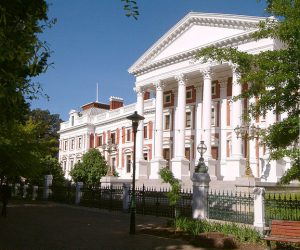
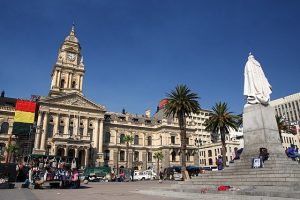


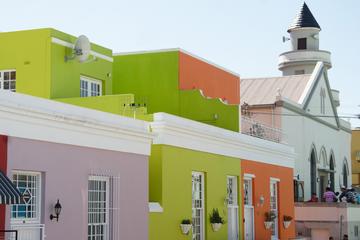
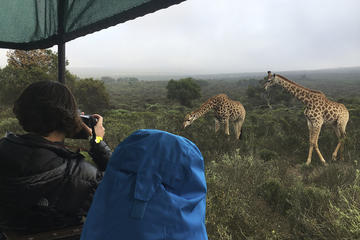
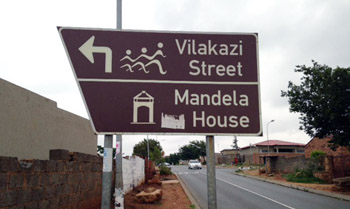
 The project was overseen by the South Africa Development Agency. “The community is very happy with the result,” says Thanduxolo Ntoyi, an assistant development manager at the agency. The community was “very involved” with the street and its transformation from the beginning.
The project was overseen by the South Africa Development Agency. “The community is very happy with the result,” says Thanduxolo Ntoyi, an assistant development manager at the agency. The community was “very involved” with the street and its transformation from the beginning.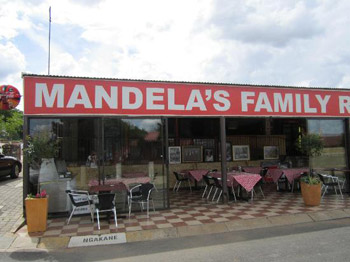 Outside the house stands a large metal outline of two bull heads, entitled The Nobel Laureates. The title refers to the fact that on the corner of Vilakazi and Ngakane Streets, a short distance away, is the Soweto home of the Anglican Archbishop Emeritus Desmond Tutu, who, like Mandela, was the recipient of a Nobel Peace Prize. The bulls look down the road, decisive and eye-catching, leaving no doubt as to the strength of the two personalities they represent. Around the corner in Moema Street is another metal depiction, this time of schoolchildren facing a policeman with a growling dog. It’s a reference to the confrontation on 16 June 1976 when hundreds of black school children were protesting the imposition of European Afrikaans in schools, when they were met by the brutality of the colonial police.
Outside the house stands a large metal outline of two bull heads, entitled The Nobel Laureates. The title refers to the fact that on the corner of Vilakazi and Ngakane Streets, a short distance away, is the Soweto home of the Anglican Archbishop Emeritus Desmond Tutu, who, like Mandela, was the recipient of a Nobel Peace Prize. The bulls look down the road, decisive and eye-catching, leaving no doubt as to the strength of the two personalities they represent. Around the corner in Moema Street is another metal depiction, this time of schoolchildren facing a policeman with a growling dog. It’s a reference to the confrontation on 16 June 1976 when hundreds of black school children were protesting the imposition of European Afrikaans in schools, when they were met by the brutality of the colonial police.
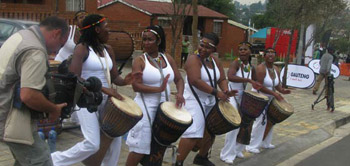 At the start of Vilakazi Street, where it intersects with Khumalo Street, is another magnificent artwork. Eight huge, grey hands spell “Vilakazi” in sign language. The hands are big and bold, but accessible to residents – they have become play objects, with children taking time out to climb on them. Other art includes two murals – one depicts the scene of June 1976, with police and their vans, and placard-carrying schoolchildren. And then there are the mosaics, livening up several concrete benches on the corner of Moema Street; down Vilakazi Street are mosaic strips of paving. On the corner of Vilakazi and Ngakane streets is a row of bollards with decorative wooden heads. Vilakazi Street is indeed a different place.
At the start of Vilakazi Street, where it intersects with Khumalo Street, is another magnificent artwork. Eight huge, grey hands spell “Vilakazi” in sign language. The hands are big and bold, but accessible to residents – they have become play objects, with children taking time out to climb on them. Other art includes two murals – one depicts the scene of June 1976, with police and their vans, and placard-carrying schoolchildren. And then there are the mosaics, livening up several concrete benches on the corner of Moema Street; down Vilakazi Street are mosaic strips of paving. On the corner of Vilakazi and Ngakane streets is a row of bollards with decorative wooden heads. Vilakazi Street is indeed a different place.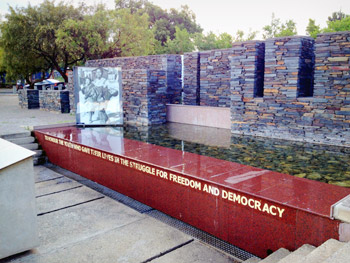 This is another landmark that enriches Vilakazi Street. This memorial has been completed, and it remembers the 15-year-old boy who was the first to be shot on 16 June 1976 riots against the white apartheid government. On the corner of Klipspruit Valley and Khumalo roads is a bridge where Hastings Ndlovu was shot by the police. He was rushed to Chris Hani Baragwanath Hospital – one of the world’s biggest hospitals- where he died of the head wound.
This is another landmark that enriches Vilakazi Street. This memorial has been completed, and it remembers the 15-year-old boy who was the first to be shot on 16 June 1976 riots against the white apartheid government. On the corner of Klipspruit Valley and Khumalo roads is a bridge where Hastings Ndlovu was shot by the police. He was rushed to Chris Hani Baragwanath Hospital – one of the world’s biggest hospitals- where he died of the head wound.